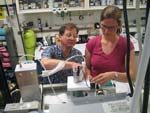Water For People will use funding to help 12 communities in the rural district of Chikwawa gain access to water, sanitation, and health and hygiene education.
EPA-NIEHS study found that an increase of 1 ppm carbon monoxide in the maximum daily one-hour exposure is linked to a 0.96 percent increase in the risk of hospitalization from cardiovascular disease for people 65 years and older.
The conference will issue protocols and proposed national warranties for homes remediated under these protocols.
The alarmist comments presented in the following article from your newsletter are very irresponsible given recent information that has come to light regarding the fact that global cooling has actually taken place over the past ten years.
Current water discharge regulations, which were issued in 1982, have not kept pace with changes in the electric power industry, EPA says.

Tom Bruno enhanced headspace analysis to improve the efficiency of sample collection, making the technique capable of detecting low concentrations of polar, low-volatility compounds.
Energy Recovery Inc. helps plant expand capacity by reducing energy used during desalination.
Georgia, Ohio, Florida and Missouri are considering opt-in programs, which eliminate the automatic delivery of white pages phone books.
If efforts to lower greenhouse gases are not successful, governments may turn to geoengineering techniques, which have not been studied or found to be effective at an affordable cost.
According to EPA, the mine owner/operator failed to collect representative samples of effluent and exceeded its NPDES permit limits.
The Walk4Water initiative seeks to encourage people to experience the 10,000 steps required to fetch water every day.
University of Utah chemists have developed a method to detect if drinking water aboard the International Space Station is adequately disinfected.
EPA and TVA are still removing ash from the Emory River and have closed sections to ensure safety at the site.
The biomass gasification system will be used to power the Stamford Water Pollution Control Authority.
N-ST*R tests mineralizable soil nitrogen, enabling farmers to better calculate the amount of nitrogen that should be applied to rice crops for maximum yield but no excess that might be carried away as runoff.
Groups cite flawed Bush-era decision for denying Endangered Species Act protection to ribbon seals.